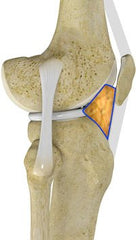Anterior Knee pain – Part II

Anterior Knee pain and the influence of the retro-patellar fat pad –Part II
We’ve just finished up discussing the anatomy and potential mechanisms of pain from the Retro-patellar Fat Pad of the knee. This part II section of the blog is dedicated to clinical significance and treatment options.
Clinical Significance:
· Distinct focus by the clinician to the quality of exercises like QS, SLR, and SAQ in open chained exercises will give valuable information about the possible amount of lateral displacement of the infra-patellar fat pad (IPFP), prompting possible mobilization of this area. Decreased efficiency of the quadriceps pulling on the patellar tendon or altered expectations of achieving full terminal extension during exercise may lead to decreased fat pad excursion and increased fibrosis or even scarring of the IPFP leading to Hoffa syndrome
· Over the years, many patients have entered my care that report seeing previous PT, home skilled care, or have all ready been doing exercises given to them from the surgeon’s office or hospital. “Oh I’ve been doing quad sets and straight leg raises at home”. After education and correction about the goal of the exercise, the patient often states “That is harder to do” or “That hurts doing it that way” or ‘That’s not what I have been doing at home”. Many have a good quad set that lacks ability to drop the knee into terminal extension, though demonstrate extensor lag during the typical flexion SLR.
Exam: This is where things might get difficulty as I am not aware of any objective testing specific to the IPFP (see Chad Cook publications for this possible info). My clinical exam typically involves passive extension to determine ROM at the knee, if there is the production of pain around the Anterior Interval (AI) and patellar tendon during this passive knee extension, palpation of this area for sensitivity (specifically to the lateral portion of the AI/patellar tendon), and quality of the patient’s Quad set and Straight Leg Raise.
If the clinician suspects anterior interval involvement then mobilization is warranted, and to be mixed with exercise.
Treatment options:
· Vigorous and/or prolonged manual mobilization of the anterior interval in multiple planes with graduated extension from 30-0 and even “passive-protective-hyperextension”. This is where I love my Motion Guidance Manual Therapy Contact Pads. There are superiorly sticky compared to other materials, with extra cushion to diminish contact soreness. But most importantly, there are HYGEINIC! Washable after each use and they return to their original stickiness
· Achieving full terminal extension ASAP. I would recommend this doesn’t mean “putting your body weight into it”. Complimentary techniques such as Mobilization with Movement often yield wonderful immediate results and encourage the quadriceps to take over the new motion that is gained during the treatment session. And patient rapport will be likely maintained by not having just drilled them with a painful overpressure.
· Loaded OKCE and CKCE with education on attaining full terminal extension during the exercises
· And finally, as a last ditch effort, I have found prone knee flexion to be of great usefulness for IPFP mobilization. Prone knee flexion draws tension over all structures at the anterior aspect of the knee. Sustained low load, long duration holds can provide mobility to these tissues. But WARNING…it hurts. Typically I will put the patient in control of the intensity, as I can’t see their face in this position, to verbally tell me when they have reached a 7/10 (totally arbitrary on my part for achieving painful but tolerated tension) as a stopping point for the stretching. To account for this type of painful knee , I will holster this type of treatment until around week 5-6 post-operatively for anything involving an anterior knee incision (ACL, TKA, Tib Tub Transfers, etc) or meniscal repairs). My reasoning? That is the very early stage of the scar maturation phase. Early healers will find this more as a stretch and appreciate the localized tissue mobility response. Delayed healers typically have enough time post surgical to tolerate this aggressive natured mobility.
Hope this review and treatment options help you find extra success and happy clients in your clinics.
-Eric


Leave a comment
Please note, comments must be approved before they are published